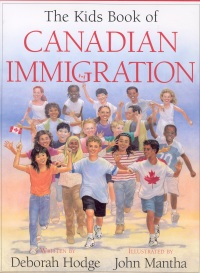| ________________
CM . . .
. Volume XIII Number 8 . . . .December 8, 2006
excerpt:
From the first people who arrived in Canada thousands of years ago to the influx of new Canadians from all over the world in the last century, this outstanding book takes readers on a journey through time, helping them to understand the cultural makeup of this country. Each of the 24 chapters provides general information about groups of immigrants as well as brief accounts of specific individuals or families. The immigrants’ reasons for coming to Canada are varied: to escape hunger, poverty, war, religious persecution, to name a few, or just, simply, to start a new life. There are stories about people from France, Britain, Eastern Europe, Hawaii, China, Japan, India, Viet Nam and many other countries. Some people, like Antonio Jiminéz, from Spain, had positive experiences to tell about their arrival in Canada. Jiminéz speaks of the “magnificent job” done by volunteers to make his arrival as stress-free as possible. Others were not so fortunate, one example being the orphaned and homeless British children who came to Canada in the early 1900s. Their painful experience is described by Robert Clapham who wrote about being haunted by the memories of being made fun of by his host family and crying himself to sleep every night. Many immigrants faced other hardships: harsh conditions, cold weather and blizzards, dust storms, drought, swarms of mosquitoes, discrimination, loneliness and isolation. Though Canada has often been considered a haven for refugees, Hodge writes with honesty and candor about the negative side of the Canadian government’s immigration policies - its list of “preferred” immigrants and the hostility shown towards certain groups of people during the First and Second World Wars when many immigrants were sent to live in internment camps and other refugees were denied entry into Canada. The strength of this book lies in the balance between general historical information and the personal stories, past and present, told by the immigrants themselves - factual details enhanced by the often heartwarming, sometimes heartbreaking, accounts of life in their newly adopted country. Hodge also describes the many contributions made to Canada by the different individuals and groups of immigrants. Mini profiles of well-known Canadians from various ethnic backgrounds - Governor General Michaèlle Jean, Stephen Lewis and Louis Riel, for instance - further demonstrate the contributions. The final chapter provides immigration facts and figures along with a pie chart denoting Canada’s cultural mix of first, second and third-generation Canadians. A table of contents, an index and a glossary are included. Illustrations consist of coloured drawings, maps, charts and archival documents. Above each chapter heading is a timeline “ribbon” which indicates the number of years ago that a particular wave of immigration took place.
Highly Recommended. Gail Hamilton is a teacher-librarian in Winnipeg, MB.
To comment
on this title or this review, send mail to cm@umanitoba.ca.
Copyright © the Manitoba Library Association. Reproduction for personal
use is permitted only if this copyright notice is maintained. Any
other reproduction is prohibited without permission.
NEXT REVIEW |
TABLE OF CONTENTS FOR THIS ISSUE
- December 8, 2006.
AUTHORS |
TITLES |
MEDIA REVIEWS |
PROFILES |
BACK ISSUES |
SEARCH |
CMARCHIVE |
HOME |
